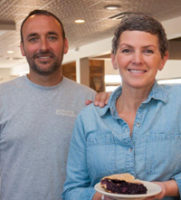Restaurant rebuilds after fire

Blueberries are to pie what Helen’s Restaurant is to Machias, Maine. As a matter of fact, Life magazine named Helen’s blueberry pie as the best in the U.S. in 2005. Finding such a culinary gem in a sleepy little coastal town goes against all odds. But, most Mainers have heard of Helen’s.
“Helen’s is a Maine landmark,” said Maine Governor Paul LePage in a news release issued after word had spread that the establishment burned down one night in July of 2014. “Open year-round, the restaurant is also a local institution and gathering place. This is a true loss for the owners, David and Julie Barker, as well as the Down East community.”
More than a year later, how the building caught fire is still a mystery. But, it matters little now; townsfolk and visitors have their beloved restaurant back. It’s been a staple to Machais for 65 years, and neither the Barkers nor the community were about to let a fire put an end to the legacy.
Just like a good meal
The owners gave trade pros a request they often get themselves: it needs to be great, but please make it quick!
“Everyone in the community wanted to see the restaurant come back together as quickly as possible,” said Jeff Huntley, owner of JL Huntley Plumbing Heating & Cooling.
After the fire, it didn’t take the Barkers long to formulate a plan for the new building. The facility would be more comfortable year-round and have an ideal kitchen and dining area layout, all while dropping from to 6,300 to 4,800 square feet. Shrinking operating costs was a focus, too.
By New Year’s Day, the lot had been cleared of rubble, and the subcontractors had been selected. Huntley would be working with general contractor Buildings Etcetera and R.M. Flagg, a commercial kitchen specialist and foodservice equipment company. The new building would be constructed with eight inches of urethane spray foam insulation to keep the heat load at roughly 130,000 BTUH.
The HVAC system consists of three main components: hydronic radiant in-slab heat to handle the brunt of northern Maine’s winter, 16 tons of mini-split heat pump capacity for precise supplemental heat and all AC, and an HRV system to provide fresh air. The kitchen is also equipped with its own cutting-edge makeup-air system.
Focus on comfort
“The multi-system approach meant that my guys were on the job almost continuously,” Huntley said. “But it also meant unparalleled comfort and efficiency, which is what the Barkers were really after. It would’ve been tough to pull it off if this wasn’t new construction.”
Huntley’s design uses two Viessmann condensing boilers to provide at least seven-and-a-half GPM of domestic hot water at 120 F as well as hot water for the slab and a small snowmelt zone. The half-inch PEX gets 80 F water on a design day to handle the base heating load. From there, precise temperature in both summer and winter is controlled via Fujitsu mini-split heat pumps.
“The radiant supply water temperature is really low, lest we overshoot the slab,” Huntley explained. “We bring the room the rest of the way up to temperature with the Fujitsu units in the winter, so it’s an extremely responsive system despite the slab’s thermal mass.”
Four Honeywell thermostats monitor the radiant system to provide the optimum temperature in heating mode. With the hydronic and ductless combo, Huntley is able to maintain temperature consistently across the whole serving floor.
Loyalty based on experience
J.L. Huntley’s eight technicians drew from a wide variety of experience to help complete the restaurant work quickly. They work on all sorts of projects in northeastern Maine; everything from correctional facilities to lobster processing plants. The tight timeline at Helen’s was their only real challenge throughout the five-month project. It was 0 F outside when the slab was poured, and temporary heat was provided through April by a small, LP-fired 125 MBH Modine Hot Dawg unit heater.
Hydronic system components share a mezzanine area with the owner’s office. All radiant loops are 200 feet in length and are piped in reverse-return configuration for thermal consistency across the slab.
Five Fujitsu Halcyon systems serve the building. Two, three-ton single-zone ceiling cassette systems, which Huntley refers to as the “workhorses,” handle half of the restaurant’s seating area. The rest of the load is handled by a wall-mounted two-ton system and a four-ton dual zone, also with wall-mounted evaporators. The Barkers also added a four-ton multi-system in the kitchen with the evaporators positioned near work stations so their staff could stay cool even on the hottest summer days.
“When I find something that works the way I want it to, I’m very loyal,” Huntley said. “I’ve been using Uponor PEX for more than 20 years, and we started using Fujitsu about 10 years ago. I’m not about to invest in training only to switch lines and start at square one again.”
According to Huntley, the same applies to where he shops. The training and support he’s received from Roger Windsor at Johnstone Supply have been second to none. To show his appreciation, he deals with Johnstone at every opportunity.
Special considerations
A wheel-type ERV capable of up to 850 CFM is used to supply fresh air. The unit operates based on CO2 levels within the space.
“The ERV was sized to provide ample fresh air for the building at maximum occupancy,” Huntley said. “It saves quite a bit of energy in both heating and cooling season, and in mild weather it’s actually used as a cooling source.”
The kitchen is served by a stand-alone captive air system, which maintains neutral- or slightly-positive pressure by introducing enough air to make up for the large commercial range hoods. During the winter, the main cooking hood is served by a 750 MBH rooftop unit, while the bakery hood needs 300 MBH.
Outside, concrete for the stairway and handicapped ramp were poured over five-eighths-inch oxygen barrier PEX. As an active member of the Machias community, Huntley felt the need to donate the tubing and labor to the project.
The project came to a close on May 1. Helen’s restaurant re-opened two weeks later after acclimating to the new building, but not before hosting all the trade workers for a breakfast — on the house!
“Patrons are now so comfortable, they don’t even know they’re comfortable!” Huntley said. “That’s true comfort, when folks can’t even tell if there’s a system running. But, I still have a few more ideas to run by the Barkers.”
He’d also like to see the restaurant outfitted with a photovoltaic solar array in the future. And ultimately, he’d like to install an air-to-water heat pump in the boiler room to use the latent heat to offset DHW production.
Folks are happy to have their favorite eatery back in business, better than ever. Without any comfort issues, visitors can concentrate on their award winning blueberry pie, or their big Maine lobster. Or both.





